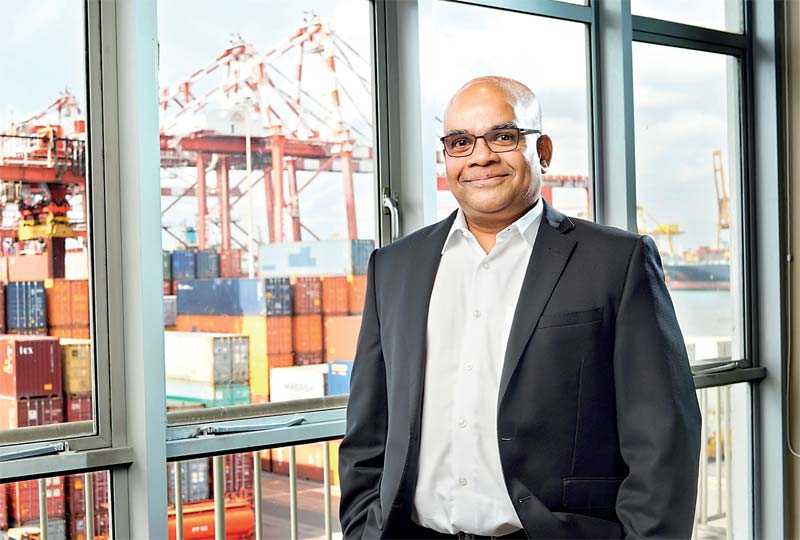Sunday Dec 15, 2024
Sunday Dec 15, 2024
Monday, 15 March 2021 02:19 - - {{hitsCtrl.values.hits}}

Romesh David
Romesh David is no stranger to the logistics world, holding various roles in it since 1980. Currently CEO of South  Asia Gateway Terminals (SAGT), he has also held the role of President – Transportation Group for John Keells Holdings, responsible for a wide gamut of companies in the sector that included integrated logistics, freight forwarding, marine fuels and lubricants, airlines and air transport and travel agency.
Asia Gateway Terminals (SAGT), he has also held the role of President – Transportation Group for John Keells Holdings, responsible for a wide gamut of companies in the sector that included integrated logistics, freight forwarding, marine fuels and lubricants, airlines and air transport and travel agency.
Romesh is also the current President of the Indo-Lanka Chamber of Commerce and Industry and was the Chairman of the Sri Lanka Freight Forwarders Association (SLFFA) during the period spanning 2000 to 2002. He has also held the post of Chairman of the Chartered Institute of Logistics and Transport (CILT) from 2012 to 2014 and is currently the International Vice President – South Asia for CILT International. We recently met Romesh at his office overlooking the bustling SAGT terminal for a candid chat on the current status, future outlook and prospects for the Ports sector in Sri Lanka, from his perspective as a terminal operator. Following are excerpts:
Entry into freight forwarding industry by accident
I fell into the freight forwarding industry by accident. In the late eighties, a good friend and myself at John Keells Holdings were invited to become Directors, as was the custom at the time, to join the boards of two subsidiaries of the Group in the transportation sector, one of which was the freight forwarding business. However, my friend had plans of his own, and thus declined the position and left the company. I found myself on the boards of several subsidiaries, including Mack International Freight.
I initially knew nothing about freight forwarding, and as I learned more about it, discovered it to be thoroughly enjoyable. Many established people were already in the industry such as S S Kumar, Diren Hallock, Hanif Yusoof, Charles Wijesundera, Sumith Guruge, Sunil Malawana, Tony de Livera and many more, and I learned a lot from them. They were household names by the time I joined this predominantly entrepreneur-driven industry, which was steered by a great set of devoted and driven individuals who continuously strove to raise the bar throughout the nineties and well into the millennium.
Exciting times – we developed a world-class industry
Sri Lanka had an open economy by the ’90s, but it was hamstrung by outdated policies, procedures and miles of red tape. The nineties were a crucial period of export development, as the garment industry was growing and the freight forwarding industry was the tip of the spear that got their products to markets around the world. Companies in Sri Lanka were continually developing, improving, and innovating. The industry was great in that it enjoyed healthy competition, coupled with collaboration at the right junctures. As a result, Sri Lankan freight forwarding entrepreneurs have expanded on a regional and global scale. Expolanka is an excellent example of a globalised Sri Lankan logistics and freight forwarding firm.
Successive chairmen of the SLFFA have continued to raise the profession to new heights, leading the industry in what is essentially a regulated space. When the Government was looking at regulating this industry, it was SLFFA that was consulted and promulgated regulation by industry related standards, which eventually became law. Standards such as competent personnel, minimum insurance levels, fiscal responsibility and many more were conceptualised, implemented, and updated by the SLFFA. During the year 2000, at the turn of the millennium, I was the SLFFA Chairman and we were all fully engaged with the Y2K notion – that the digital world would be disrupted as the calendar rolled from 99 to 00. Thankfully, our fears were unfounded.
The current port situation – Lady Luck has smiled on us – but for how long?
Our container volumes were growing robustly at a compound rate of around 6% year-on-year over the past decade and transhipment cargo is what kept us growing through the years. Over 80% of our total containerised cargo volumes comprise of transhipment cargo, close to 70% of which is to and from India. On the back of the COVID-19 pandemic, 2020 was a relatively bad year with a drop in volume of a little over 5%, but it could have been worse if not for the swift recovery in transhipment. Imports crashed due to the Government’s tightening aimed at conserving foreign exchange. Exports took a bad hit at the start of the year, but recovered as the year progressed, helped by COVID-19 related global demand and Government policies aimed at boosting them.
The Port of Colombo was relatively unaffected by the first wave, but the second wave hit us harder, with effects lasting a few weeks. These mainly stemmed from unrealistic income expectations caused by uncertainties of some Port employees as to their health and prospects if they caught the dreaded virus. This was compounded by an influx of containers due to volume increases, and we had congested yards, with more ships waiting outside to unload and load cargoes as well. October and November were the crunch months, but things began to ease back to normal by December. In fact, we are better than other ports such as Singapore and Long Beach (California) which are still experiencing congestion and significant delays at the time of this interview in February 2021.
Transhipment drives capacity…or capacity drives transhipment?
Around 80% of our volumes are transhipment, and transhipment is a capacity-driven business. Lines will watch closely and extensively evaluate ports to determine if they have capacity before they decide to utilise them for transhipment or increase their transhipment businesses at these ports. If you are close to full capacity, it is unlikely that you will attract more transhipment business, as it is a time-critical business. Vessel operators do not want to waste their time at congested ports with long delays to berth, high loading and unloading times and other time-consuming factors. They seek efficient and productive ports with sufficient available capacity so that they can ensure quick turnaround of their vessels.
Colombo is currently operating at close to 90% of capacity. We handled 7.2 million TEUs in 2019. With some effort and planning, we could maybe nudge 7.8 or even 8 million TEUs, but that will not be comfortable. In that way, COVID-19’s resulting drop in volumes gave us some much-needed breathing space. However, we are still in the deep end in terms of current and immediate future prospects. Historically, we have lagged behind on the capacity curve and not added enough capacity in a timely manner. As a result, we lose some current and potential transhipment business.
JCT was holding fort until SAGT came online around the early 2000s, increasing capacity. The 2007-2008 Financial Crisis came by, and we got some respite as a result of that, else we would have had a capacity crunch by then. CICT came online in 2014 when it should have come maybe two or three years earlier. Likewise, we should have had ECT by 2017 or 2018 at the latest. By 2019, things were looking dicey again and we were at risk of losing some transhipment business. In a perverse sort of way, 2020 and COVID-19 bought us a little time, but it is not enough.
It must be clearly understood that in the transhipment business, ports need to build capacity in order to gain demand – not the other way round. In this context and notwithstanding the recent spate of drama around it, it is imperative that the Government/SLPA get their act together and work with a definitive plan to add much needed capacity by commissioning the ECT and beyond, in a timely and productive manner. We desperately need the enhanced capacity if Colombo is move to the next levels of transhipment.
The location factor
Location is an often-used term when referring to Sri Lanka’s Ports. Yes, location is important. Take major cities such as Singapore, Hong Kong, Rotterdam, and London. They are all Port cities that developed as a result of location. Now let us take the Port of Aden of Yemen. It is a brilliant location, at the mouth of the Red Sea. However, it has not developed, as doing business in Yemen is tough. Location is one factor amongst many, and not a sole deciding factor for Port operators and users. Yes, we sit within a stone’s throw of the major East-West shipping lane. But merely sitting there is not enough. We must offer plenty of integrated services to not only entice traffic to our Ports but also become a logistics and maritime hub.
Potential as a logistics and maritime hub
Sri Lanka has the potential to become a logistics hub. We have a fantastic location. We sit at the foot of the second most populous market in the world, in terms of a consumer as well as producer. We should not just focus on transhipment, but become a cargo hub, where we provide the full gamut of cargo services, including loose cargo, air cargo, LCL (Less Container Load), consolidation, warehousing, supply chain management, value addition, redistribution, and related services.
Let us go even further and focus on becoming a maritime hub, considering our location and the potential to add multi-dimensional connected businesses. The maritime industry is in want of a myriad of services that can easily be addressed by us. Crew changes are of utmost importance, given that at any times, there are over 200,000 seafarers serving on ships, or waiting to board and disembark.
Ships themselves have a variety of needs including provisions for the crews (victualling), fuel (bunkering), marine lubricants, engineering services, spare parts, certification renewals, dispute resolutions and a whole array of related services. Cruise liners can also be encouraged to visit Sri Lanka with integrated air-sea-land packages. We have all the necessary attributes to become a maritime centre of excellence, we just need the right policies, frameworks, and clear execution strategies.
FDI is a crucial pillar to development, and we must adjust our mindset
In order to accomplish this, we need to encourage FDI (Foreign Direct Investment) and create a compelling proposition for foreign talent to invest and provide expertise to Sri Lanka. Sri Lankans are great at going overseas and excelling, and we must channel that drive for excellence to develop our country as well, aided by foreign expertise where required. Colombo is after all a very liveable city, and we can easily induce foreign companies to set up here, employing expats as well as locals towards building and developing diverse businesses within and related to the maritime industry.
Successful countries have done this. Dubai, for example is now offering citizenship for experienced professionals. Singapore welcomes foreign labour where required, and the local workforce has benefited as there is now direct salary parity – locals and foreigners in the same position enjoy equal pay. We must re-adjust our perspective from the ‘selling of assets’ mentality. After all, leasing land is the safest form of foreign investment, as we gain infrastructure, and it is not possible for the investor to dig out that building or warehouse or uproot that Port and take it back with them!